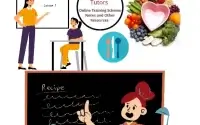Characteristics of Living Things for JSS 1
LESSON PLAN: CHARACTERISTICS OF LIVING THINGS
Subject: Basic Science
Class: JSS 1
Term: Second Term
Week: 3
Age: 8 – 9 years
Topic: Characteristics of Living Things
Sub-topic: Characteristics of Plants and Animals
Duration: 40 Minutes
Behavioural Objectives
By the end of the lesson, pupils should be able to:
- Define living things and state their characteristics.
- Identify different types of plants and animals.
- Differentiate between plants and animals based on their characteristics.
- Explain how plants and animals meet their basic needs.
Keywords
- Living things
- Characteristics
- Plants
- Animals
- Movement
- Nutrition
- Reproduction
Set Induction
The teacher brings a live plant and a small pet (e.g., a picture or video of a cat or bird) to class. The teacher asks the pupils:
- “What do you notice about these two things?”
- “Can they move?”
- “Do they eat food?”
- “Can they grow?”
The teacher listens to pupils’ responses and explains that both are living things but have different characteristics.
Entry Behaviour
Pupils already know the difference between living and non-living things from the previous lesson.
Learning Resources and Materials
- Charts showing different plants and animals.
- Live plants or pictures of trees, flowers, and herbs.
- Pictures or models of vertebrates and invertebrates.
- A short video showing movement in plants and animals.
Building Background/Connection to Prior Knowledge
- The teacher reminds pupils about living and non-living things discussed in the previous lesson.
- The teacher asks: “Can a stone grow? Can a dog grow?”
- The teacher explains that living things show characteristics like movement, feeding, and reproduction.
Embedded Core Skills
- Critical Thinking
- Observation
- Communication
- Classification
Reference Books
- Lagos State Scheme of Work
- Basic Science Textbook for Primary Schools
- Teacher’s Guide on Living and Non-Living Things
Instructional Materials
- Charts of different plants and animals
- Pictures or videos showing movement in plants and animals
- Real or artificial flowers, herbs, and small tree branches
Content
1. Definition of Living Things
Living things are things that have life and can perform basic activities like moving, breathing, feeding, and reproducing.
2. Characteristics of Living Things (MR NIGER D)
- Movement – Plants move slowly, while animals move actively.
- Respiration – Living things take in air (oxygen) to stay alive.
- Nutrition – Plants make their own food, while animals eat food from plants or other animals.
- Irritability – Living things respond to changes in their environment.
- Growth – Living things increase in size and height.
- Excretion – They remove waste materials from their bodies.
- Reproduction – Living things give birth or produce new ones of their kind.
- Death – All living things eventually die.
3. Classification of Living Things
Living things are grouped into:
- Plants – Examples: Mango tree, hibiscus flower, maize, yam.
- Animals – Examples: Goat, dog, cow, fish, bird.
4. Types of Plants
Plants can be grouped into:
- Trees – Mango, orange, pawpaw.
- Flowers – Hibiscus, rose, sunflower.
- Herbs – Carpet grass, aloe vera.
5. Types of Animals
Animals are classified into:
- Vertebrates – Have backbones (e.g., man, dog, goat).
- Invertebrates – Have no backbone (e.g., butterfly, cockroach).
6. Differences Between Plants and Animals
| S/N | Characteristics | Plants | Animals |
|---|---|---|---|
| 1 | Movement | Passive | Active |
| 2 | Reproduction | Mostly asexual | Mostly sexual |
| 3 | Nutrition | Make their own food | Depend on others for food |
| 4 | Irritability | Slow response to stimuli | Quick response to stimuli |
| 5 | Excretion | No developed excretory system | Well-developed excretory system |
| 6 | Respiration | No complex respiratory organs | Have complex respiratory organs |
| 7 | Sense Organs | No sense organs | Have sense organs |
Evaluation Questions (Fill in the Blanks)
- Living things have life, but ______ things do not.
a) Non-living
b) Dead
c) Small
d) Fast - The ability of living things to take in air is called ______.
a) Irritability
b) Respiration
c) Growth
d) Reproduction - ______ make their own food using sunlight.
a) Animals
b) Humans
c) Plants
d) Insects - Animals depend on ______ for food.
a) Plants
b) Water
c) Air
d) Stones - Plants respond to changes in their environment ______ than animals.
a) Faster
b) Slower
c) Louder
d) Quicker - Animals have a well-developed ______ system for excretion.
a) Digestive
b) Excretory
c) Sensory
d) Reproductive - Living things can produce young ones through ______.
a) Eating
b) Sleeping
c) Reproduction
d) Running - Which of these is a vertebrate?
a) Cockroach
b) Man
c) Ant
d) Spider - Plants and animals both ______ as they get older.
a) Shrink
b) Grow
c) Disappear
d) Change color - An example of an invertebrate is a ______.
a) Cow
b) Fish
c) Butterfly
d) Dog
Class Activity Discussion (FAQs and Answers)
- What are living things?
Living things are things that have life and can move, grow, and reproduce. - What are the two main types of living things?
Plants and Animals. - How do plants get food?
They make their own food using sunlight (photosynthesis). - Do all animals move?
Yes, animals move actively to find food and escape danger. - What do plants need to grow?
Water, air, and sunlight. - How do animals reproduce?
Most animals reproduce sexually by giving birth to young ones or laying eggs. - What is an example of a tree?
Mango tree. - What is an example of an invertebrate?
Cockroach. - Why do living things excrete?
To remove waste materials from their bodies. - Do plants have sense organs?
No, only animals have sense organs.
Presentation Steps
- Teacher revises the previous topic.
- Teacher introduces the new topic.
- Teacher allows pupils to contribute and corrects them where necessary.
Assessment (Evaluation Questions)
- Define living things.
- Mention two characteristics of living things.
- What are the two types of living things?
- Give two examples of plants.
- State one difference between plants and animals.
Conclusion
The teacher marks pupils’ work, provides corrections, and summarizes the lesson.
Related Posts


Pathogens, Diseases & Their Prevention | JSS 1 PHE Lesson Note
JSS 1 FIRST TERM LESSON NOTES BASIC TECHNOLOGY


Healthy Ears and Nose: Structure, Functions, and Care Home Economics JSS 1 First Term Lesson Notes Week 4
About The Author
Edu Delight Tutors
Am a dedicated educator with a passion for learning and a keen interest in technology. I believe that technology can revolutionize education and am committed to creating an online hub of knowledge, inspiration, and growth for both educators and students. Welcome to Edu Delight Tutors, where learning knows no boundaries.